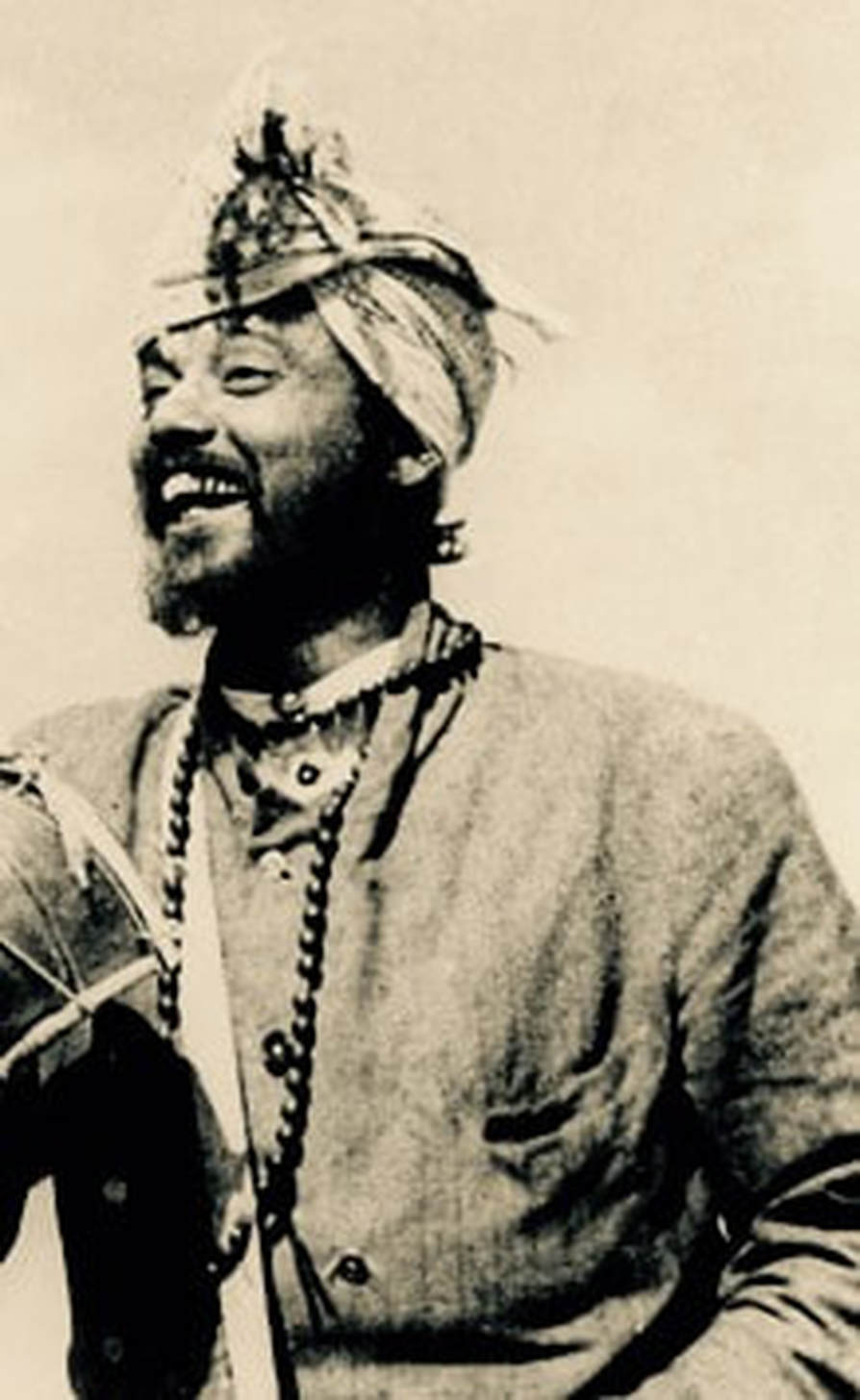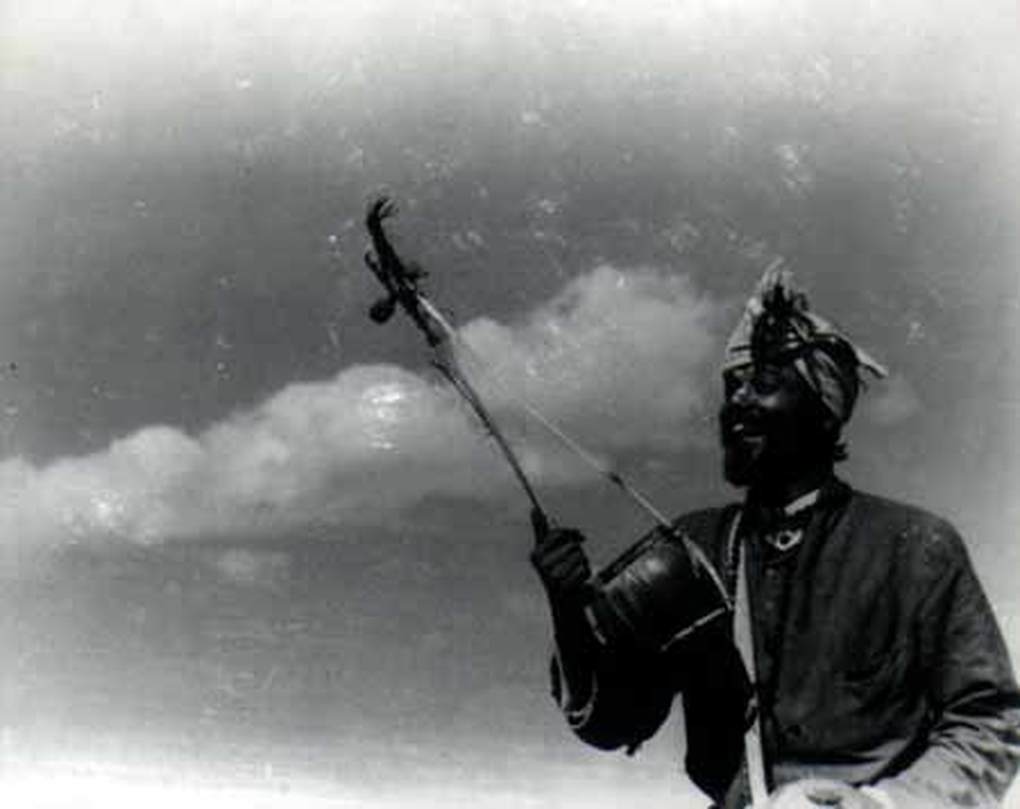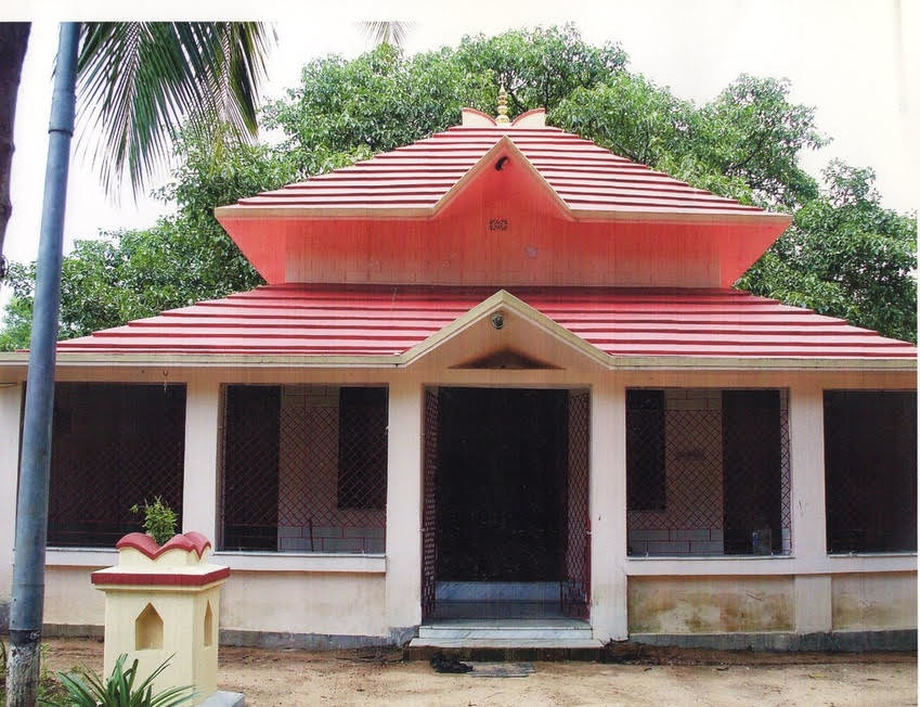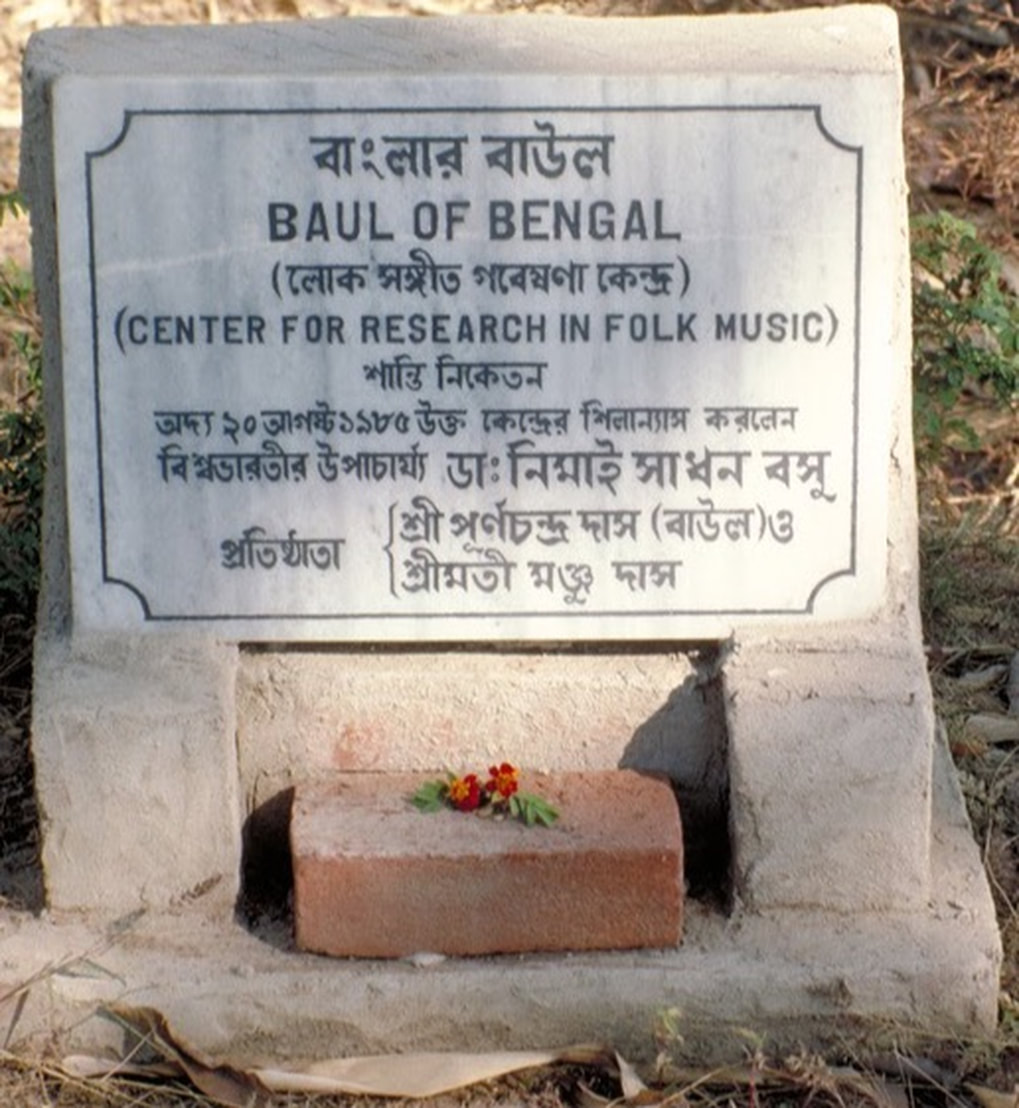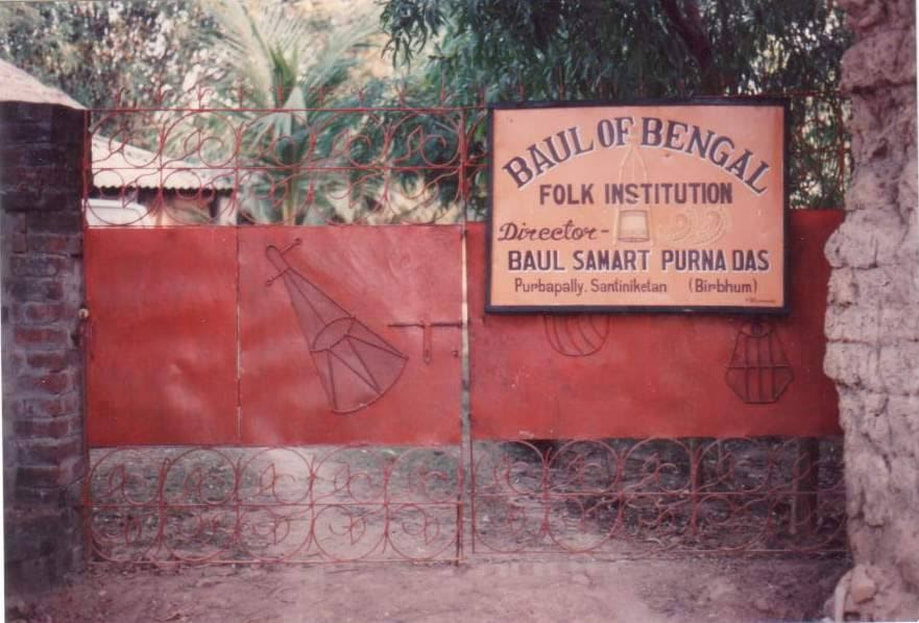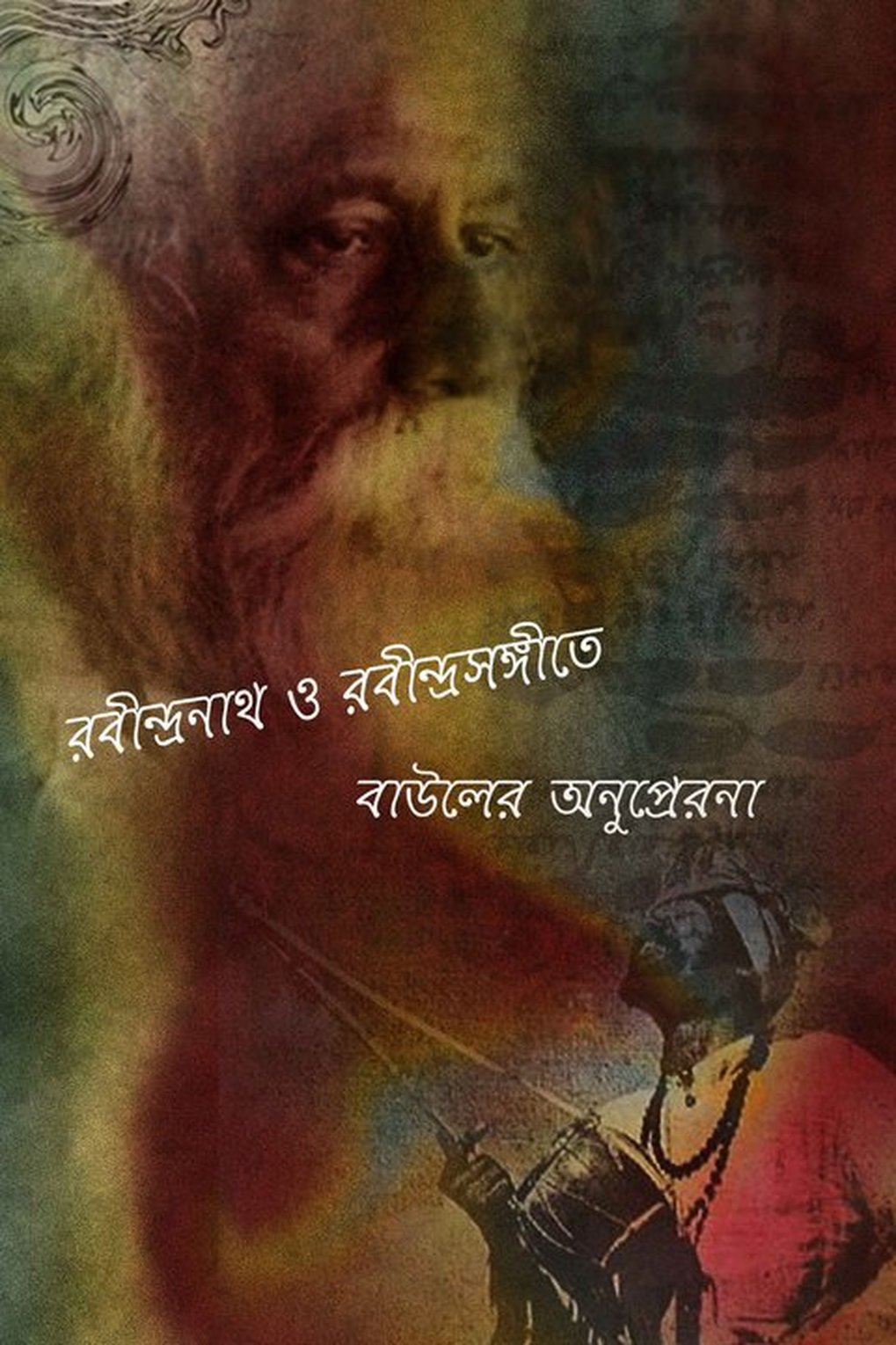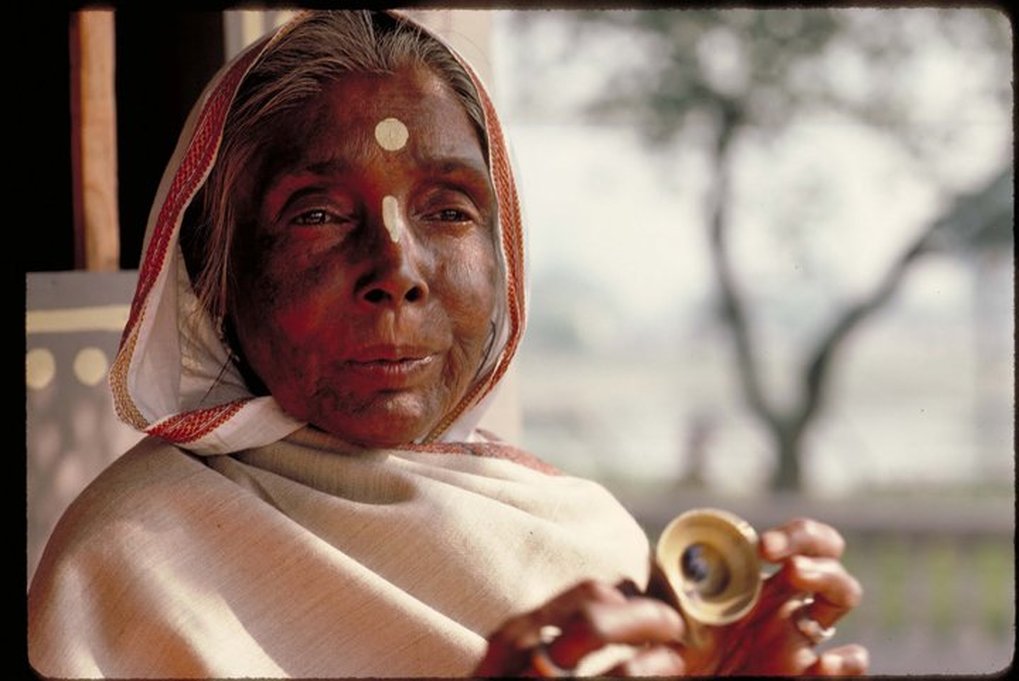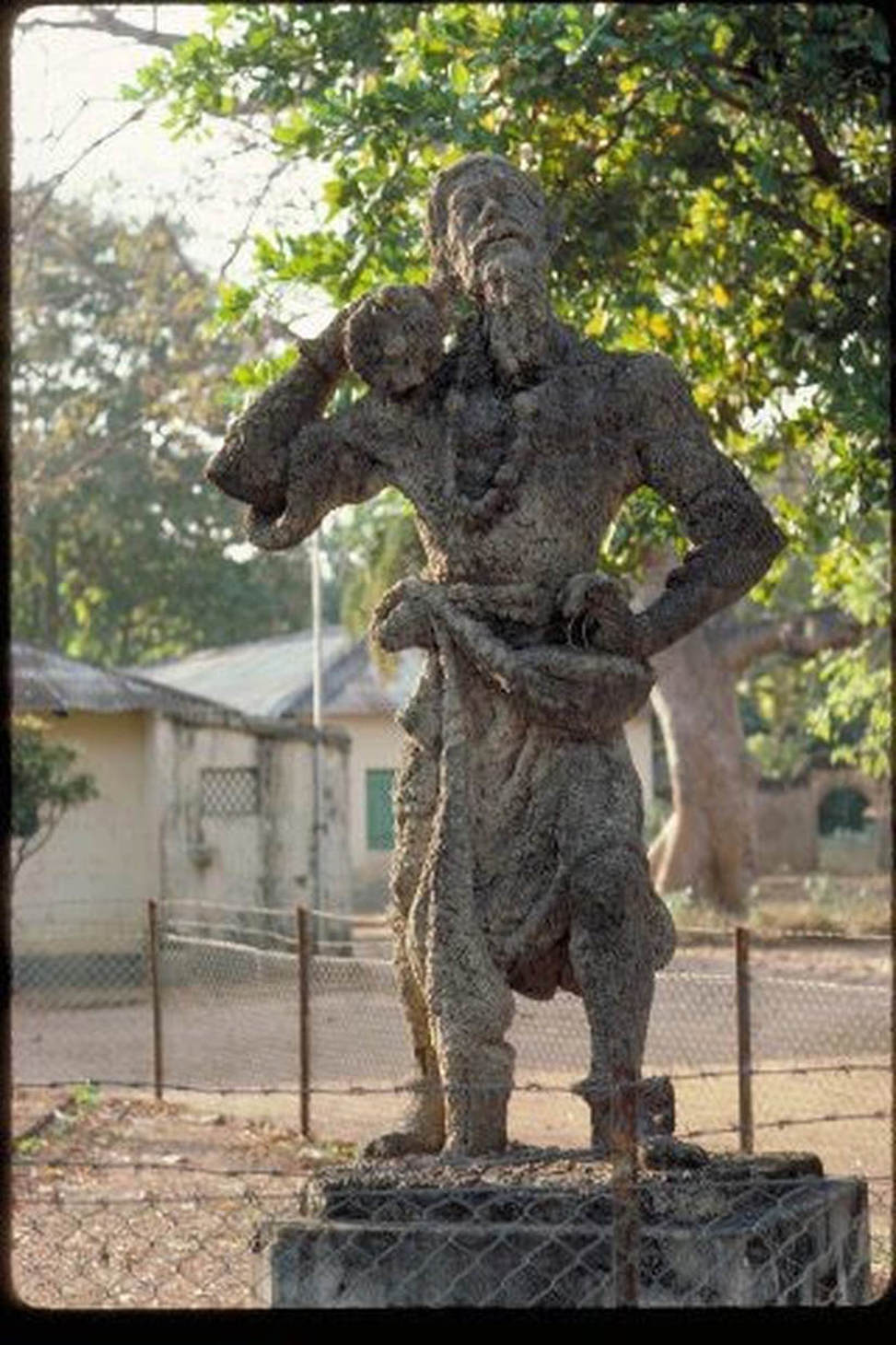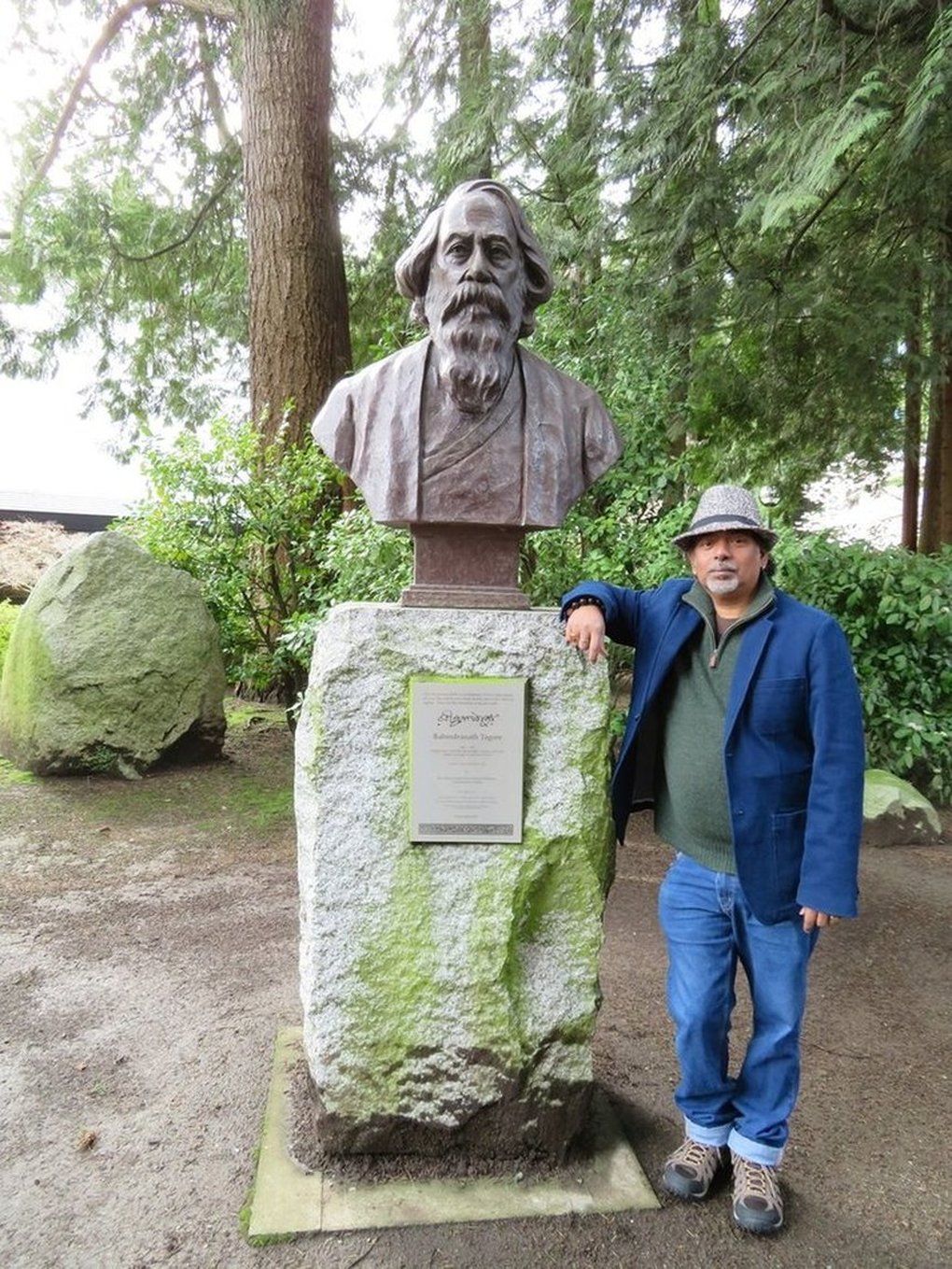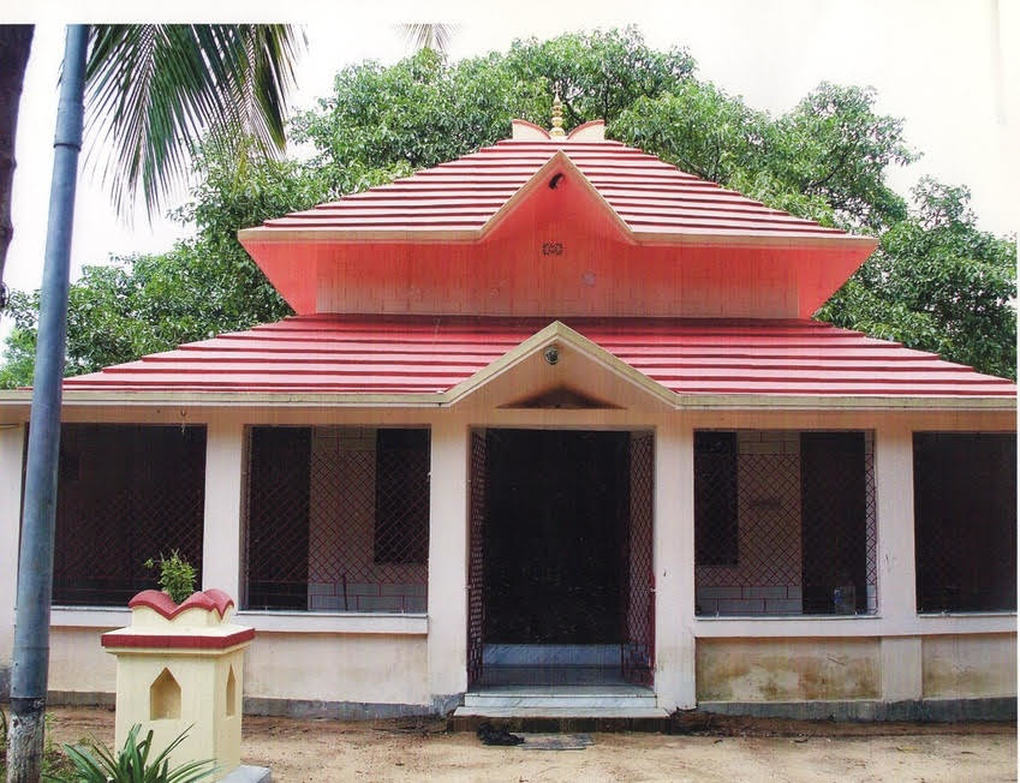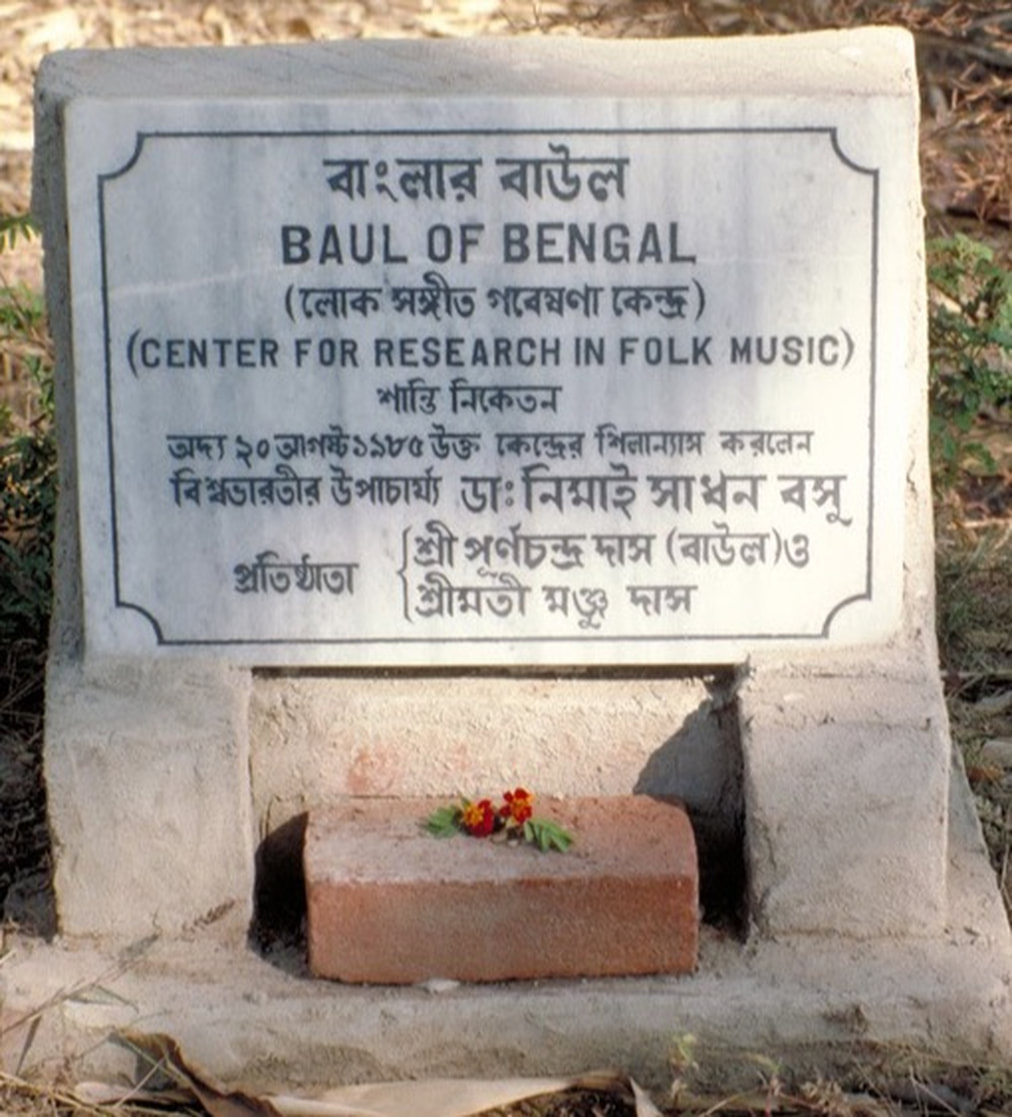The above photo of Nabani Das Khyepa Baul, taken by Rabindra Nath Togore.
Nabani Das Khyapa Baul is the Baul Guru who was best friends with Tagore and the Baul Guru who initiated Tagore into Baul giving him the name Robi (Ravi) Baul.
A Baul Song written by Rabindranath Tagore, and gifted to Nabani Das "Khyapa".
Sung by Purna Chandra Das.
The entire right of this song now belongs to the descendants of Nabani Das.
This song is not available in any of Vishwabharati's documents.
This song does not exist in "Geetabitan" or even "Rabindra Rachanabali"
(The Entire Collected Works of Rabindranath Tagore).
What is interesting in this song is the "bhuni" added by the poet.
As a tradition, baul songs are always sung and picked up by others; it is is never "written".
So the authors add a line in the song or poem, revealing their own identity, so that the his name can remain attached to his creation.
Rabindranath followed the same tradition here and added the word "Thakur Robi bole.".
Nabani Das Kyapa Baul
VAISHNAVA BAULS OF BIRBHUM BENGAL
by Sandra Trishula Das December, 2015
Editor's Note: The following is an excerpt from a soon to be released book by Trishula, 'The Rasa Lila Mystics'. Sutra Journal is honored to include her story, which makes reference to not only the musical fame of the Bauls, but also the depth and integrity of their lineage and sadhana. Trishula is married to Babukishan, the protagonist of the story.
The Oral and Intangible Heritage of Humanity
“That is why, brother, I became a madcap Baul. No master I obey, nor injunctions, canons or custom. Now no men-made distinctions have any hold on me, and I revel only in the gladness of my own welling love. In love there's no separation, but commingling always. So I rejoice in song and dance with each and all."
Rabindra Nath Tagore, The Hibbert Lecture, Oxford, 1930
Rabindranath Tagore became a Baul when the legendary Sri Nabani (Gosia) Das Khyappa Baul gave Tagore the name Ravi (Robi) Baul and in return Tagore gave Nabani (Noboni) the name Khyappa Baul and named him 'Mirror of the Sky'. To this very day villagers in Birbhum remember a legendary Tantric Vaishnav Baul Saint Avadhut named Nabani Das Khyappa Baul.
Nabani Das Khyappa Baul and his wife & Monar Manush (soul mate) Brajabala Dasi.
Khyappa means sat chit ananda, highly mystical, fully awake, aware, divine ecstatic love, wild, free bird, blissful, divine consciousness, magical, mysterious, out of body connected to the divine at a very high level, khyappa is not something that can be faked. It is not a name for everybody it was a name designated for a Avadhut, however, today everybody is calling themselves khyappa as many are calling themselves ‘Baul’ and ‘Baul Guru’.
Rabindranath Tagore the great Bengali Noble prize winner for literature and the writer of the Indian, Bangladeshi, and Sri Lankan national anthems, loved Nabani and Nabani is the only Baul who inspired and associated with Tagore.
In 2005, UNESCO Declared the Baul Tradition a "Masterpiece of the Oral and Intangible Heritage of Humanity".
The Mirror of the sky, reflects my soul. O Baul of the road, O Baul of the heart, What keeps you tied, to the corner of the room. By Nabani Das KHYAPPA Baul.
To the untrained eye and ear wandering and singing a song does not make one a Baul. Rabindranath honoured Nabani because he was an ecstatic mystic full of wisdom, he admired his poetry, his tune and his depth in sadhana as a Tantric Yogi and Baul Avadhut. Rabindranath respected Nabani's ancient lineage and its richness, authentic cultural significance and tradition of wisdom, along with the energetic live wire shaktified pure ecstatic love that Nabani embodied.
Tagore appointed Nabani Das Baul as a Professor of Baul music and dance at the Tagore Vishva Bharti University that Tagore created in Shantineketan. Nabani is the first and last Baul to teach at Vishva Bharti University. One of Nabani's students was Indira Gandhi, her father Jawaharlal Nehru had the greatest respect for Nabani. The Indian Independence movement was in full swing. Nehru appointed Nabani a state singer in 1947, where Nabani along with Nehru and his contingent travelled all over India, playing for people, sharing the magic of Baul and Nehru's political messages.
Like his grandfather, KD Babukishan also traveled with his parents around India as state singers for Indira Gandhi, with whom Babu's mother was best friends with her until her tragic death. They also were state singers for Rajiv Gandhi until Rajiv's death.
Guru Shishya Parampara Sampradaya Lineage KD Babukishan and his Guru Grandfather Baul Saint Nabani Das Khyappa Baul. Bauls are Tantrics, Indian musicians who know the Tantra of Sound, Mystical Bards, Guru's, Pandits, Acharya's who are simply called Baul.
Jawaharlal Nehru, the first Prime Minister of India, was wise enough to know what the scholar Sri Chaitanya had figured out 500 years before, that Bauls were able to draw people together through their energetic shakti and ecstatic charismatic chanting, singing and dancing. Dry scholarship and talking doesn't necessarily awaken people to a new movement. Sri Nitanyanda of Ekchakra Birbhum was a Vaishnava Baul and the ancestor of this lineage, he was elder to Sri Chaitanya. It was Nitanyanada who taught his Baul tradtion of kirtan, singing and dancing to Sri Chaitanya.
Sri Chaityana started his Hari Krishna movement based on the ecstatic 'Hari Krishna Hari Ram' singing and dancing of the Vaishnava Baul of Birbhum. The Bauls would start with the Hari Krishna chant early in the mornings as a wakeup call announcing their presence to the villagers of Bengal, inviting them to listen and learn about spiritual life.
Baul is a rare, esctatic, super charged and sweet heart-opening devotional singing and Baul Kirtan is full of ecstatic energy that turns even the hardest of hearts to honey, bringing the rasa of ananda (bliss) alive. They play a one stringed trance inducing instrument called an ‘ektara’ also called the ‘Gopi Chand’ or ‘Gopi Yantra’ which is the Bauls symbol of peace and unity for all. A Baul plays a variety of instruments including a rare one or two stringed instrument called a ‘Gubgubi’ which Nabnai himself named the Ananada Lahari meaning ‘waves of bliss’. Baul is a Guru Shishya Parampara Sampradaya, they are sadhu's and belong to sadhu sangha which are called Akaras. There used to be 22 such sanghas, now there are only 2, they are almost extinct.
There is a lot of misinformation about the Bauls today, misrepresentations abound among a new generation of Baul singers, scholars, writers, documentary film makers, information found on wikipedia, Gurus from other sects including Osho who wrote many books on the Bauls and was deeply inspired by Nabani Das Khyappa Baul. All of them have completely missed the point of who these sweet devotional people are. They repeat the same thing over and over and it is not accurate. Many fakes are changing this beautiful tradition, they dress the part, singing out of tune trying to copy what can not be copied. Baul is only achieved through sadhana. The fake Bauls say they are sadhakas to attract students, some say they are sexual tantrics as sex always sells. This has gone on for a long time. Unaware foreigners attracted by sexual tantra of the west, and Indians attracted by the dream of sexual freedom, flock to Shantineketan. Yet the real Bauls are now almost extinct, and those that still remain, live marginalized in poverty.
Bauls have been described as mad, fakir, dervish, aula, Muslim, afflicted by the wind, illiterate, beggars and folk singers, yet they are none of the above. Bauls were the biggest peacekeepers accepting all people. Understanding the history of Bengal is very important to understanding Baul. When Bengal was in strife under Islamic invasion they accepted Sufi into their fold, learning and adding some Sufi techniques in their practice. When Buddhists flowed into Bengal and were challenged by Brahamins, Bauls were the only people who gave them refuge and accepted them. Baul is a sect onto its own based on Sanatan Dharma with a sprinkle of Sufi and Buddhist practices.
Stories abound about Bauls being from Persia, Uzbeckistan or Bangladesh, but many of these speculations are coming out of Bangladesh which is a Muslim country. They have somehow appropriated Baul culture and use this as a way to raise huge amount of money, apparently in order to preserve Baul Tradition as their ‘National heritage’. Baul tradition was born thousands of years ago and is indigenous to and originates from Birbhum Bengal. There were no Bauls in Bangledesh, even when Bangaldesh was Bengal they were not from the place now called Bangladesh. Baul has always been based on Sanatan Dharma, the eternal dharma of India as found in the Bhagavad Gita, Upanishads, Puranic and Vedic wisdom. There were no Bauls in Bangladesh prior to the 1970's because Babu's mother Manju was a well know family in that area before it became Bangladesh.
Baul is a tradition of Krishna and Kali kirtan.
Kenduli Birbhum Bengal is the home of the Joy DEV Baul Mela. JOY Dev wrote the Gita Govinda about the love between Radha and Krishna. 1986 Photo by Babukishan of Kenduli at the Joy Dev Mela. The Pous Mela in Shantineketan was created by Rabindranath Tagore in honour of Nabani Das Baul to bring together intellectuals, poets, and creative artists from around the world.
This story comes from the oral tradition of the oldest living Baul lineage as told by Babukishan aka Krishnendu Das Baul, a ‘Lineage Baul Guru’ and the only Baul Guru Scholar from inside the tradition of the Vaishnava Bauls of Birbhum Bengal. Babukishan has lectured all over the world for decades at the University level and has done Baul preformances on some of the biggest stages in the world since the 1970's.
Baul is not only an ocean of devotion but is also, an ocean of Indian Philosophy, Yoga, Tantra, Vedic, Puranic, and Upanishad wisdom. The title 'Baul' implies one is a Guru, Pandit, Acharya, an authority, they were the Shastra before books, they are oral storytellers, spiritual Bards, Bhakti Yogi's, Masters of Nada Yoga, and Vayu Dharma. However, being an oral tradition did not mean they didn't read Bengali and Sanskrit manuscripts and Shastra.
KD Babukishan was born in 1962 in Suri Bhirbhum W Bengal into the lap of Nabani Das Khappa Baul and his wife Brajabala Dasi. KD Babukishan is the birth son of Purna Das Baul and Manju Dasi, however and for whatever reason he was left right after his birth to be raised by Sri Nabani, his Sad Guru and grandfather. Nabani and Brajabala raised their little grandson who was born premature with crooked limbs, it was thought he would die the next day. They named him Krishnendu (Krishna in Bengali). The name Babukishan was given to him by Mahesh Bhatt a Hindi film Director and Suraj Sanim one of the biggest Hindi film writers.
Nabani was an adept Sadhaka at Tarapith he took his sick tiny premature grandson with crooked limbs to Tara Maa right after he was born praying and begging for his life; Ayurvedic medicine, prayers and mantra were used to heal baby Krishnendu and his limbs were straightened through daily Ayurvedic massage given by Nabani and Brajabala Dasi. It should be noted that Nabani was a healer and he had healed thousands of people eveywhere he went, taking their karma and transmuting it.
Nabani knew the Tantra of alchemy and traditional herbs, he was a close friend of the famed Ayurvedic doctor and healer Dr. Kali Goti who also helped with healing Babu. Nabani was an adept at manifesting siddhi's, he knew all the Guru's, Saints, Siddhas, Yogis, Naths, Swamis, Sadhus, Sadhakas of the time and had them all give dharshan and blessings to his little baby Krishnendu. Babu went everywhere with Nabani and was a regular at Tarapith learning tantric and Baul sadhana. hanging out with the Gurus and Tantrics one could say he owes his life to Tara Maa and Kali Maa. The village Rakha Kali Maa temple where he played, was right beside the Ratha Yatra Cart with Radha and Krishna. The village favoured many gods. Babu saw and experienced a world that does not exist today, those times are gone. I specualate that perhaps this was Babu's karma and a continuation of his past life.
Nabani's samadhi was in 1969, when KD Babukishan was only 8 years old. He thought Nabani was his father, until he learned his real father was Nabani's eldest son Purna Das Baul who had since had two other sons that were raised outside Baul tradition, in contemporary Calcutta. Most people on a path would agree that our family is not who we are. Guru is our real family if we are lucky to have one, Babu was lucky to have Nabani who left him his spark. Losing Nabani was to be the greatest loss of little KD Babukishan's life and the greatest loss to the whole Baul community. Nabani was not an ordinary Baul he was an extraordinary genius. Babukishan was by his side when he went into samadhi.
On his grandfather’s passing, KD Babukishan recalls: “suddenly he reached out and gave me his hand at the same time a huge thunder cracked as his whole body turned a blue whitish and an electric current shocked me and ran through my body at the same time automatically the tulsi plant fell over and the Bhagavad Gita hit Boro Baba on his head, he was gone. He held my hand so tight I felt an electric current run through my body my third eye opened, I saw the universe my Boro Baba had given me what is called a Bramhma dharshan. I felt a huge force of power and light in my body, I couldn't break free of Boro Baba's grip.”
This is a section of the wall at the Joy Dev temple in Kendula.
The Joy Dev Baul Mela is held here the Vaishnava Bauls attend ever year to do puja to the great poet (kavi) Joy Dev. The bridge going across the Ajoy river is named Nabani Setu after Nabani Das Baul. The mela is completely different today, the Bauls have been marginalized and pushed out by the new kirtan singers. The Bauls honour Joy Deva and the love he had for his soul mate Padmavati because Bauls believe in Soul Mates as Radha and Krishna live and dance in their hearts, this is the real Rasa Lila dance. The temple wall is made from soil that has been burnt hundred of years ago. The Joy Dev Baul festival takes place every year on Markar Sanskranti when the Sun moves into Capricorn.
The Baul kirtan for Nabani went on for weeks, they chanted HARI KRISHNA HARI RAM for 8 days in a continuous flow, and then 6 more weeks taking breaks for some food and rest. Thousands of people came to pay their respects. Nabani was a famous father figure, Baul Guru of Birbhum, a state artist and the whole state of Birbhum was closed. He was burried in traditional Baul way, sitting in a padmasana.
Some time after his grandfather’s death, his Grandmother sent him to live in Calcutta with Purna Das Baul and Manju Dasi, his birth parents, as she felt he’d be better off there and that he needed to be educated. KD Babukishan's went from the highest energy and biggest love bliss to a material life in Calcutta and a family where he didn't fit in. He recalls how his mother Manju used to bribe him with cookies to call her Maa.
Those days were hard for a little boy, suddenly surrounded by strangers, in the strange city, and before long, they packed him off to Ramakrishna Mission, where he remained for the following twelve years. Living there was tough, but the Swami’s there respected the Bauls, and often told him the story how Ramakrishna loved the Bauls, and said many times how he wanted to be born a Baul in his next life.
The family sometimes let him stay with them and even travel with them, touring with his father. When he was nine, they went to London and Europe on his first of many overseas trips. They went to perform at the fundraiser for Bangladesh in 1971, 1972, and 1978. There was a big group of Indian musicians who played at Hyde Park at the concert sponsored by the Beatles and The Rolling Stones. That is where he first met and became lifelong friends with George Harrison and the Rolling Stones. Later in 1986, George Harrison along with Ravi Shankar helped him publish his 3rd book on Bauls, now out of print. During that trip they traveled to Mick Jaggers place in Nice, France and where his father recorded with them for the album Jai Bangla. Mick Jagger was their limousine driver, and drove them from the airport to his place, and in 2004 he returned the favour when The Rolling Stones performed in Mumbai.
Just as he was in the process of becoming a sanaysin, his father pulled him out of Ramakrishna Mission to work as his tour manager.
The easiest way to pronounce Baul is (Ba–oo-l). Bauls are known as 'wind catchers' , the Masters of Pranayama which they call Vayu Dharma. Baul comes from the words Vayu (air) and T'ula (to raise the vital air). Ba stands for Va in Bengali language. Bauls practice various yogic tantric techniques and their singing and mantric chanting. The aim of the Baul is God Realization & Self Realization in the human body, humanity is first and foremost to the Bauls – to be a good human, to realize God within this body temple.
Bauls are considered to be Sahaja which means natural and spontaneous. It implies natural on the spiritual level and on the mystical level of the miraculous. It means that easy natural state of living without planning, design, contriving, seeking, wanting, or striving for attention.
Bauls practice techniques similar to Daoist Qigong they are Masters of energy work and mysticism.
FAMOUS BAULSPurna Das Baul is the first famous Indian Vocalist to come to America. First arriving in 1967 on a tour from San Francisco to New York staying in Woodstock NY at Bob Dylan's home as guests of Sally and Albert B Grossman (Bob Dylans manager). The recorded music from that time is called 'Bauls at Big Pink'. Purna Das Baul and his brother the late Laxshman Das Baul who was a much loved Baul a Bob Marley of the Bauls appeared on the cover of Bob Dylan's Legendary album John Westly Harding, Bob Dylan was a super fan of Lakshman Das Baul. Sally Grossman has remained a loyal a very dear friend of the Bauls and Laxshman Das Baul since 1967. At 81 years of age Lashman Das Baul passed away in April 2015 ending a legendary period of Baul history.
Left - Lakshman Das Baul, Bob Dylan, Purna Das Baul, I don't know the fellow in the back.
The Bauls at Big Pink produced by Al Aronowitz the father of Rock Journalism and another beloved friend of Babu's who passed in 2004, Garth Hudson and Robbie Robertson of the Band 1967 / The photo of Nabani Das Khyappa Baul was taken by Rabindranath Tagore. The Bauls on this album are Purna Das Baul and Lakshman Das Baul
Baul Samarat (King of the Bauls) Purna Das Baul at 82 years old has recieved the highest awards as a vocalist in India including many President Awards, Padma Shri and a rare award from the JAGANATHA TEMPLE called 'Nada Brahma Award' which only 3 have received including the much celebrated Ravindra Jain and Lata Mangeshakar. This family of Vaishnava Bauls are celebrated at the Jaganatha Temple in Orissa they know they are ancestors of Nityananda, Jai Nitai.
Allen Ginsberg's had always honoured Nabani Das Baul as his Guru who he first met him in the early 1960's while traveling in Bengal. Ginsberg became a very dear friend of KD Babukishan whom Babu visited every year in America from the 1980's until Ginsberg passed, they are both poets and have a love for Nabani Das Baul. Ginsberg is the one who insisted to Sally and Albert B Grossman (Bob Dylan's manager) to bring Nabani to America, however, in 1967 Nabani's health was failing and he sent his two son's Lakshman and Purna Das Baul.
Kshiti Mohan Sen was a well-known scholar of ancient and medieval India and close associate of Rabindranath Tagore served as the Vice Chancellor of Visva-Bharati University in Santineketan for years. Kshiti Mohan Shastri described Nabani Das Baul "the last real true Baul" he wrote a book on Baul and regarded Nabani as the greatest ocean of intelligence he was as a huge admirer of Nabani. Kriti Mohan Sastri is the Grandfather of Armarta Sen a Professor, Economist and Philosopher living in New York.
KD Babukishan walks between worlds in a true tantric form with one foot in the spiritual world and one foot firmly on earth, in the world but not of the world. He is a highly awarded Bollywood Indian Cinema Music Composer, Indian Music Producer, a Master of Indian Music, Classical, Folk, Bhajan, and Kirtan composing scores for 150 films, Film Designer, Film Maker, he has recorded and worked with the who is who of Indian music and Western music.
KD Babukisha was raised a Baul and spent 12 years as a Ramakrishna monk in Calcutta, BA in Indian Philosophy, MA of Indian Music from Calcutta University, Poet, the first Baul to be educated in the oral tradition and outside. A Sanskrit Scholar from the Oral Tradition, Sanskrit Education at the Masters level and because of his love of Sanskrit he spent countless years learning from Dr. Roma Chowdhri who was like a mother to Babu she was a legendary world renowned Bengali Sanskrit scholar who dedicated her whole life to Sanskrit.
Baukishan now lives in Vancouver Canada with me Trishula his Monar Manush wife and partner of almost ten years, traveling back and forth to India. Babu's life changed dramatically when he was in the 2004 Tsunami in Indonesia where he witnessed, tens of thousands of souls leaving Bhumi Maa all at once, one of Maa's biggest smashen grounds. He has lived through the 1971 war between Bengal and Bangladesh, he has lived through many many terrorist attacks in Mumbai and lived many lifetimes in this one lifetime. Babu's main cause has always been to preserve his Baul tradition and it has been proven a difficult task it seems that over many decades his dream, all of his time and energy have been thwarted by his Calcutta family and many other road blocks, but he never gives up.
"The way my braid is, that’s how it will stay.
I’ll get into the water, I’ll splash water around, but I won’t get my hair wet.
I’ll swim about this way, and that way.
I’ll dive into the water, and won’t listen to what people say.
I’ll enjoy myself but not suffer because of it.
Gosain Rasaraj says: “Listen, my friend , that beauty leaves me speechless".
I won’t be chaste; I won’t be unchaste.
I won’t leave my Lord".
Famous Baul song (poetry) by Rasaraj Gosai (Nabani Das Baul's elder brother)
by Sandra Trishula Das December, 2015
Editor's Note: The following is an excerpt from a soon to be released book by Trishula, 'The Rasa Lila Mystics'. Sutra Journal is honored to include her story, which makes reference to not only the musical fame of the Bauls, but also the depth and integrity of their lineage and sadhana. Trishula is married to Babukishan, the protagonist of the story.
The Oral and Intangible Heritage of Humanity
“That is why, brother, I became a madcap Baul. No master I obey, nor injunctions, canons or custom. Now no men-made distinctions have any hold on me, and I revel only in the gladness of my own welling love. In love there's no separation, but commingling always. So I rejoice in song and dance with each and all."
Rabindra Nath Tagore, The Hibbert Lecture, Oxford, 1930
Rabindranath Tagore became a Baul when the legendary Sri Nabani (Gosia) Das Khyappa Baul gave Tagore the name Ravi (Robi) Baul and in return Tagore gave Nabani (Noboni) the name Khyappa Baul and named him 'Mirror of the Sky'. To this very day villagers in Birbhum remember a legendary Tantric Vaishnav Baul Saint Avadhut named Nabani Das Khyappa Baul.
Nabani Das Khyappa Baul and his wife & Monar Manush (soul mate) Brajabala Dasi.
Khyappa means sat chit ananda, highly mystical, fully awake, aware, divine ecstatic love, wild, free bird, blissful, divine consciousness, magical, mysterious, out of body connected to the divine at a very high level, khyappa is not something that can be faked. It is not a name for everybody it was a name designated for a Avadhut, however, today everybody is calling themselves khyappa as many are calling themselves ‘Baul’ and ‘Baul Guru’.
Rabindranath Tagore the great Bengali Noble prize winner for literature and the writer of the Indian, Bangladeshi, and Sri Lankan national anthems, loved Nabani and Nabani is the only Baul who inspired and associated with Tagore.
In 2005, UNESCO Declared the Baul Tradition a "Masterpiece of the Oral and Intangible Heritage of Humanity".
The Mirror of the sky, reflects my soul. O Baul of the road, O Baul of the heart, What keeps you tied, to the corner of the room. By Nabani Das KHYAPPA Baul.
To the untrained eye and ear wandering and singing a song does not make one a Baul. Rabindranath honoured Nabani because he was an ecstatic mystic full of wisdom, he admired his poetry, his tune and his depth in sadhana as a Tantric Yogi and Baul Avadhut. Rabindranath respected Nabani's ancient lineage and its richness, authentic cultural significance and tradition of wisdom, along with the energetic live wire shaktified pure ecstatic love that Nabani embodied.
Tagore appointed Nabani Das Baul as a Professor of Baul music and dance at the Tagore Vishva Bharti University that Tagore created in Shantineketan. Nabani is the first and last Baul to teach at Vishva Bharti University. One of Nabani's students was Indira Gandhi, her father Jawaharlal Nehru had the greatest respect for Nabani. The Indian Independence movement was in full swing. Nehru appointed Nabani a state singer in 1947, where Nabani along with Nehru and his contingent travelled all over India, playing for people, sharing the magic of Baul and Nehru's political messages.
Like his grandfather, KD Babukishan also traveled with his parents around India as state singers for Indira Gandhi, with whom Babu's mother was best friends with her until her tragic death. They also were state singers for Rajiv Gandhi until Rajiv's death.
Guru Shishya Parampara Sampradaya Lineage KD Babukishan and his Guru Grandfather Baul Saint Nabani Das Khyappa Baul. Bauls are Tantrics, Indian musicians who know the Tantra of Sound, Mystical Bards, Guru's, Pandits, Acharya's who are simply called Baul.
Jawaharlal Nehru, the first Prime Minister of India, was wise enough to know what the scholar Sri Chaitanya had figured out 500 years before, that Bauls were able to draw people together through their energetic shakti and ecstatic charismatic chanting, singing and dancing. Dry scholarship and talking doesn't necessarily awaken people to a new movement. Sri Nitanyanda of Ekchakra Birbhum was a Vaishnava Baul and the ancestor of this lineage, he was elder to Sri Chaitanya. It was Nitanyanada who taught his Baul tradtion of kirtan, singing and dancing to Sri Chaitanya.
Sri Chaityana started his Hari Krishna movement based on the ecstatic 'Hari Krishna Hari Ram' singing and dancing of the Vaishnava Baul of Birbhum. The Bauls would start with the Hari Krishna chant early in the mornings as a wakeup call announcing their presence to the villagers of Bengal, inviting them to listen and learn about spiritual life.
Baul is a rare, esctatic, super charged and sweet heart-opening devotional singing and Baul Kirtan is full of ecstatic energy that turns even the hardest of hearts to honey, bringing the rasa of ananda (bliss) alive. They play a one stringed trance inducing instrument called an ‘ektara’ also called the ‘Gopi Chand’ or ‘Gopi Yantra’ which is the Bauls symbol of peace and unity for all. A Baul plays a variety of instruments including a rare one or two stringed instrument called a ‘Gubgubi’ which Nabnai himself named the Ananada Lahari meaning ‘waves of bliss’. Baul is a Guru Shishya Parampara Sampradaya, they are sadhu's and belong to sadhu sangha which are called Akaras. There used to be 22 such sanghas, now there are only 2, they are almost extinct.
There is a lot of misinformation about the Bauls today, misrepresentations abound among a new generation of Baul singers, scholars, writers, documentary film makers, information found on wikipedia, Gurus from other sects including Osho who wrote many books on the Bauls and was deeply inspired by Nabani Das Khyappa Baul. All of them have completely missed the point of who these sweet devotional people are. They repeat the same thing over and over and it is not accurate. Many fakes are changing this beautiful tradition, they dress the part, singing out of tune trying to copy what can not be copied. Baul is only achieved through sadhana. The fake Bauls say they are sadhakas to attract students, some say they are sexual tantrics as sex always sells. This has gone on for a long time. Unaware foreigners attracted by sexual tantra of the west, and Indians attracted by the dream of sexual freedom, flock to Shantineketan. Yet the real Bauls are now almost extinct, and those that still remain, live marginalized in poverty.
Bauls have been described as mad, fakir, dervish, aula, Muslim, afflicted by the wind, illiterate, beggars and folk singers, yet they are none of the above. Bauls were the biggest peacekeepers accepting all people. Understanding the history of Bengal is very important to understanding Baul. When Bengal was in strife under Islamic invasion they accepted Sufi into their fold, learning and adding some Sufi techniques in their practice. When Buddhists flowed into Bengal and were challenged by Brahamins, Bauls were the only people who gave them refuge and accepted them. Baul is a sect onto its own based on Sanatan Dharma with a sprinkle of Sufi and Buddhist practices.
Stories abound about Bauls being from Persia, Uzbeckistan or Bangladesh, but many of these speculations are coming out of Bangladesh which is a Muslim country. They have somehow appropriated Baul culture and use this as a way to raise huge amount of money, apparently in order to preserve Baul Tradition as their ‘National heritage’. Baul tradition was born thousands of years ago and is indigenous to and originates from Birbhum Bengal. There were no Bauls in Bangledesh, even when Bangaldesh was Bengal they were not from the place now called Bangladesh. Baul has always been based on Sanatan Dharma, the eternal dharma of India as found in the Bhagavad Gita, Upanishads, Puranic and Vedic wisdom. There were no Bauls in Bangladesh prior to the 1970's because Babu's mother Manju was a well know family in that area before it became Bangladesh.
Baul is a tradition of Krishna and Kali kirtan.
Kenduli Birbhum Bengal is the home of the Joy DEV Baul Mela. JOY Dev wrote the Gita Govinda about the love between Radha and Krishna. 1986 Photo by Babukishan of Kenduli at the Joy Dev Mela. The Pous Mela in Shantineketan was created by Rabindranath Tagore in honour of Nabani Das Baul to bring together intellectuals, poets, and creative artists from around the world.
This story comes from the oral tradition of the oldest living Baul lineage as told by Babukishan aka Krishnendu Das Baul, a ‘Lineage Baul Guru’ and the only Baul Guru Scholar from inside the tradition of the Vaishnava Bauls of Birbhum Bengal. Babukishan has lectured all over the world for decades at the University level and has done Baul preformances on some of the biggest stages in the world since the 1970's.
Baul is not only an ocean of devotion but is also, an ocean of Indian Philosophy, Yoga, Tantra, Vedic, Puranic, and Upanishad wisdom. The title 'Baul' implies one is a Guru, Pandit, Acharya, an authority, they were the Shastra before books, they are oral storytellers, spiritual Bards, Bhakti Yogi's, Masters of Nada Yoga, and Vayu Dharma. However, being an oral tradition did not mean they didn't read Bengali and Sanskrit manuscripts and Shastra.
KD Babukishan was born in 1962 in Suri Bhirbhum W Bengal into the lap of Nabani Das Khappa Baul and his wife Brajabala Dasi. KD Babukishan is the birth son of Purna Das Baul and Manju Dasi, however and for whatever reason he was left right after his birth to be raised by Sri Nabani, his Sad Guru and grandfather. Nabani and Brajabala raised their little grandson who was born premature with crooked limbs, it was thought he would die the next day. They named him Krishnendu (Krishna in Bengali). The name Babukishan was given to him by Mahesh Bhatt a Hindi film Director and Suraj Sanim one of the biggest Hindi film writers.
Nabani was an adept Sadhaka at Tarapith he took his sick tiny premature grandson with crooked limbs to Tara Maa right after he was born praying and begging for his life; Ayurvedic medicine, prayers and mantra were used to heal baby Krishnendu and his limbs were straightened through daily Ayurvedic massage given by Nabani and Brajabala Dasi. It should be noted that Nabani was a healer and he had healed thousands of people eveywhere he went, taking their karma and transmuting it.
Nabani knew the Tantra of alchemy and traditional herbs, he was a close friend of the famed Ayurvedic doctor and healer Dr. Kali Goti who also helped with healing Babu. Nabani was an adept at manifesting siddhi's, he knew all the Guru's, Saints, Siddhas, Yogis, Naths, Swamis, Sadhus, Sadhakas of the time and had them all give dharshan and blessings to his little baby Krishnendu. Babu went everywhere with Nabani and was a regular at Tarapith learning tantric and Baul sadhana. hanging out with the Gurus and Tantrics one could say he owes his life to Tara Maa and Kali Maa. The village Rakha Kali Maa temple where he played, was right beside the Ratha Yatra Cart with Radha and Krishna. The village favoured many gods. Babu saw and experienced a world that does not exist today, those times are gone. I specualate that perhaps this was Babu's karma and a continuation of his past life.
Nabani's samadhi was in 1969, when KD Babukishan was only 8 years old. He thought Nabani was his father, until he learned his real father was Nabani's eldest son Purna Das Baul who had since had two other sons that were raised outside Baul tradition, in contemporary Calcutta. Most people on a path would agree that our family is not who we are. Guru is our real family if we are lucky to have one, Babu was lucky to have Nabani who left him his spark. Losing Nabani was to be the greatest loss of little KD Babukishan's life and the greatest loss to the whole Baul community. Nabani was not an ordinary Baul he was an extraordinary genius. Babukishan was by his side when he went into samadhi.
On his grandfather’s passing, KD Babukishan recalls: “suddenly he reached out and gave me his hand at the same time a huge thunder cracked as his whole body turned a blue whitish and an electric current shocked me and ran through my body at the same time automatically the tulsi plant fell over and the Bhagavad Gita hit Boro Baba on his head, he was gone. He held my hand so tight I felt an electric current run through my body my third eye opened, I saw the universe my Boro Baba had given me what is called a Bramhma dharshan. I felt a huge force of power and light in my body, I couldn't break free of Boro Baba's grip.”
This is a section of the wall at the Joy Dev temple in Kendula.
The Joy Dev Baul Mela is held here the Vaishnava Bauls attend ever year to do puja to the great poet (kavi) Joy Dev. The bridge going across the Ajoy river is named Nabani Setu after Nabani Das Baul. The mela is completely different today, the Bauls have been marginalized and pushed out by the new kirtan singers. The Bauls honour Joy Deva and the love he had for his soul mate Padmavati because Bauls believe in Soul Mates as Radha and Krishna live and dance in their hearts, this is the real Rasa Lila dance. The temple wall is made from soil that has been burnt hundred of years ago. The Joy Dev Baul festival takes place every year on Markar Sanskranti when the Sun moves into Capricorn.
The Baul kirtan for Nabani went on for weeks, they chanted HARI KRISHNA HARI RAM for 8 days in a continuous flow, and then 6 more weeks taking breaks for some food and rest. Thousands of people came to pay their respects. Nabani was a famous father figure, Baul Guru of Birbhum, a state artist and the whole state of Birbhum was closed. He was burried in traditional Baul way, sitting in a padmasana.
Some time after his grandfather’s death, his Grandmother sent him to live in Calcutta with Purna Das Baul and Manju Dasi, his birth parents, as she felt he’d be better off there and that he needed to be educated. KD Babukishan's went from the highest energy and biggest love bliss to a material life in Calcutta and a family where he didn't fit in. He recalls how his mother Manju used to bribe him with cookies to call her Maa.
Those days were hard for a little boy, suddenly surrounded by strangers, in the strange city, and before long, they packed him off to Ramakrishna Mission, where he remained for the following twelve years. Living there was tough, but the Swami’s there respected the Bauls, and often told him the story how Ramakrishna loved the Bauls, and said many times how he wanted to be born a Baul in his next life.
The family sometimes let him stay with them and even travel with them, touring with his father. When he was nine, they went to London and Europe on his first of many overseas trips. They went to perform at the fundraiser for Bangladesh in 1971, 1972, and 1978. There was a big group of Indian musicians who played at Hyde Park at the concert sponsored by the Beatles and The Rolling Stones. That is where he first met and became lifelong friends with George Harrison and the Rolling Stones. Later in 1986, George Harrison along with Ravi Shankar helped him publish his 3rd book on Bauls, now out of print. During that trip they traveled to Mick Jaggers place in Nice, France and where his father recorded with them for the album Jai Bangla. Mick Jagger was their limousine driver, and drove them from the airport to his place, and in 2004 he returned the favour when The Rolling Stones performed in Mumbai.
Just as he was in the process of becoming a sanaysin, his father pulled him out of Ramakrishna Mission to work as his tour manager.
The easiest way to pronounce Baul is (Ba–oo-l). Bauls are known as 'wind catchers' , the Masters of Pranayama which they call Vayu Dharma. Baul comes from the words Vayu (air) and T'ula (to raise the vital air). Ba stands for Va in Bengali language. Bauls practice various yogic tantric techniques and their singing and mantric chanting. The aim of the Baul is God Realization & Self Realization in the human body, humanity is first and foremost to the Bauls – to be a good human, to realize God within this body temple.
Bauls are considered to be Sahaja which means natural and spontaneous. It implies natural on the spiritual level and on the mystical level of the miraculous. It means that easy natural state of living without planning, design, contriving, seeking, wanting, or striving for attention.
Bauls practice techniques similar to Daoist Qigong they are Masters of energy work and mysticism.
FAMOUS BAULSPurna Das Baul is the first famous Indian Vocalist to come to America. First arriving in 1967 on a tour from San Francisco to New York staying in Woodstock NY at Bob Dylan's home as guests of Sally and Albert B Grossman (Bob Dylans manager). The recorded music from that time is called 'Bauls at Big Pink'. Purna Das Baul and his brother the late Laxshman Das Baul who was a much loved Baul a Bob Marley of the Bauls appeared on the cover of Bob Dylan's Legendary album John Westly Harding, Bob Dylan was a super fan of Lakshman Das Baul. Sally Grossman has remained a loyal a very dear friend of the Bauls and Laxshman Das Baul since 1967. At 81 years of age Lashman Das Baul passed away in April 2015 ending a legendary period of Baul history.
Left - Lakshman Das Baul, Bob Dylan, Purna Das Baul, I don't know the fellow in the back.
The Bauls at Big Pink produced by Al Aronowitz the father of Rock Journalism and another beloved friend of Babu's who passed in 2004, Garth Hudson and Robbie Robertson of the Band 1967 / The photo of Nabani Das Khyappa Baul was taken by Rabindranath Tagore. The Bauls on this album are Purna Das Baul and Lakshman Das Baul
Baul Samarat (King of the Bauls) Purna Das Baul at 82 years old has recieved the highest awards as a vocalist in India including many President Awards, Padma Shri and a rare award from the JAGANATHA TEMPLE called 'Nada Brahma Award' which only 3 have received including the much celebrated Ravindra Jain and Lata Mangeshakar. This family of Vaishnava Bauls are celebrated at the Jaganatha Temple in Orissa they know they are ancestors of Nityananda, Jai Nitai.
Allen Ginsberg's had always honoured Nabani Das Baul as his Guru who he first met him in the early 1960's while traveling in Bengal. Ginsberg became a very dear friend of KD Babukishan whom Babu visited every year in America from the 1980's until Ginsberg passed, they are both poets and have a love for Nabani Das Baul. Ginsberg is the one who insisted to Sally and Albert B Grossman (Bob Dylan's manager) to bring Nabani to America, however, in 1967 Nabani's health was failing and he sent his two son's Lakshman and Purna Das Baul.
Kshiti Mohan Sen was a well-known scholar of ancient and medieval India and close associate of Rabindranath Tagore served as the Vice Chancellor of Visva-Bharati University in Santineketan for years. Kshiti Mohan Shastri described Nabani Das Baul "the last real true Baul" he wrote a book on Baul and regarded Nabani as the greatest ocean of intelligence he was as a huge admirer of Nabani. Kriti Mohan Sastri is the Grandfather of Armarta Sen a Professor, Economist and Philosopher living in New York.
KD Babukishan walks between worlds in a true tantric form with one foot in the spiritual world and one foot firmly on earth, in the world but not of the world. He is a highly awarded Bollywood Indian Cinema Music Composer, Indian Music Producer, a Master of Indian Music, Classical, Folk, Bhajan, and Kirtan composing scores for 150 films, Film Designer, Film Maker, he has recorded and worked with the who is who of Indian music and Western music.
KD Babukisha was raised a Baul and spent 12 years as a Ramakrishna monk in Calcutta, BA in Indian Philosophy, MA of Indian Music from Calcutta University, Poet, the first Baul to be educated in the oral tradition and outside. A Sanskrit Scholar from the Oral Tradition, Sanskrit Education at the Masters level and because of his love of Sanskrit he spent countless years learning from Dr. Roma Chowdhri who was like a mother to Babu she was a legendary world renowned Bengali Sanskrit scholar who dedicated her whole life to Sanskrit.
Baukishan now lives in Vancouver Canada with me Trishula his Monar Manush wife and partner of almost ten years, traveling back and forth to India. Babu's life changed dramatically when he was in the 2004 Tsunami in Indonesia where he witnessed, tens of thousands of souls leaving Bhumi Maa all at once, one of Maa's biggest smashen grounds. He has lived through the 1971 war between Bengal and Bangladesh, he has lived through many many terrorist attacks in Mumbai and lived many lifetimes in this one lifetime. Babu's main cause has always been to preserve his Baul tradition and it has been proven a difficult task it seems that over many decades his dream, all of his time and energy have been thwarted by his Calcutta family and many other road blocks, but he never gives up.
"The way my braid is, that’s how it will stay.
I’ll get into the water, I’ll splash water around, but I won’t get my hair wet.
I’ll swim about this way, and that way.
I’ll dive into the water, and won’t listen to what people say.
I’ll enjoy myself but not suffer because of it.
Gosain Rasaraj says: “Listen, my friend , that beauty leaves me speechless".
I won’t be chaste; I won’t be unchaste.
I won’t leave my Lord".
Famous Baul song (poetry) by Rasaraj Gosai (Nabani Das Baul's elder brother)
Brajabala Dasi, was Nabani Das Khyapa Bauls wife, the was the only Mother Babu Kishan aka Krishnendu Das knew up until age 8, she was Babu's Grandmother and Guru, she was an ORAL Sanskrit-ist and a true Vaishnava Baul. A very shy and profound storyteller, she knew all the stories of her husband and of all scripture.
RABINDRANATH TAGORE COMMISSIONED RAM KINKAR BAJ TO SCULPT THIS STATUE OF NABANI DAS KYAPA BAUL, IT STANDS AT VISVA BHARTI UNIVERSITY IN SANTINIKETAN
To the untrained eye and ear wandering and singing a song does not make one a Baul. Rabindranath honoured Nabani because he was an ecstatic mystic full of wisdom, he admired his poetry, his tune and his depth in sadhana as a Tantric Yogi and Baul Avadhut. Rabindranath respected Nabani's ancient lineage and its richness, authentic cultural significance and tradition of wisdom, along with the energetic live wire shaktified pure ecstatic love that Nabani embodied.
Tagore appointed Nabani Das Baul as a Professor of Baul music and dance at the Tagore Vishva Bharti University that Tagore created in Shantineketan. Nabani is the first and last Baul to teach at Vishva Bharti University. One of Nabani's students was Indira Gandhi, her father Jawaharlal Nehru had the greatest respect for Nabani. The Indian Independence movement was in full swing.
In 1947 Nehru appointed Nabani a state singer, where Nabani along with Nehru and his contingent travelled all over India, playing for people, sharing the magic of Baul and Nehru's political messages. No one had ever heard a Baul before outside of Bengal. Nabani would sing and like the Pied Piper the people would come from far and wide.
To the untrained eye and ear wandering and singing a song does not make one a Baul. Rabindranath honoured Nabani because he was an ecstatic mystic full of wisdom, he admired his poetry, his tune and his depth in sadhana as a Tantric Yogi and Baul Avadhut. Rabindranath respected Nabani's ancient lineage and its richness, authentic cultural significance and tradition of wisdom, along with the energetic live wire shaktified pure ecstatic love that Nabani embodied.
Tagore appointed Nabani Das Baul as a Professor of Baul music and dance at the Tagore Vishva Bharti University that Tagore created in Shantineketan. Nabani is the first and last Baul to teach at Vishva Bharti University. One of Nabani's students was Indira Gandhi, her father Jawaharlal Nehru had the greatest respect for Nabani. The Indian Independence movement was in full swing.
In 1947 Nehru appointed Nabani a state singer, where Nabani along with Nehru and his contingent travelled all over India, playing for people, sharing the magic of Baul and Nehru's political messages. No one had ever heard a Baul before outside of Bengal. Nabani would sing and like the Pied Piper the people would come from far and wide.
Babu Kishan standing next to a statue of Rabindra Nath Tagore at
The University of British Columbia, B.C. Canada
The University of British Columbia, B.C. Canada
